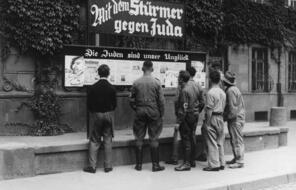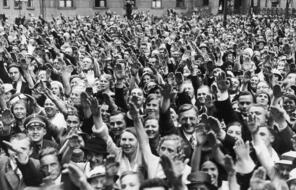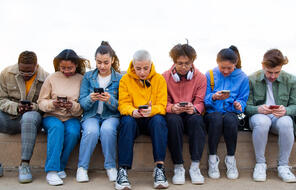Shaping Public Opinion (Abridged)
At a Glance
Language
English — USSubject
- History
- The Holocaust
- Propaganda
As the Nazis eliminated civil liberties in Germany and opened the first concentration camps to imprison “enemies of the state,” they were also trying to win public approval for their government. According to historian Robert Gellately,
Hitler and his henchmen did not want to cower the German people as a whole into submission, but to win them over by building on popular images, cherished ideals, and long held phobias in the country. . . . [The Nazis] aimed to create and maintain the broadest possible level of popular backing. They expended an enormous amount of energy and resources to track public opinion and to win over people. 1
The Reich Ministry of Public Enlightenment and Propaganda played a key role in the Nazis’ efforts to cultivate favorable public opinion. Propaganda is biased or misleading information that is used to influence public opinion. Hitler created the new ministry on March 13, 1933, and put Joseph Goebbels in charge. It was his job “not just to present the regime and its policies in a positive light, but to generate the impression that the entire German people enthusiastically endorsed everything it did.” 2
To generate excitement and enthusiasm for the Nazi Party and for Hitler himself, Goebbels and his ministry created new festivals and holidays, such as the celebration of Hitler’s birthday. They changed street names and other public signage to erase reminders of the Weimar Republic. They organized party rallies and dramatic torch-lit parades to demonstrate public support.
Writing in 1939, journalist Sebastian Haffner described these demonstrations and recalled the effect they had on many Germans.
[O]ne was permanently occupied and distracted by an unending sequence of celebrations, ceremonies, and national festivities. It started with a huge victory celebration before the elections on March 4 . . . There were mass parades, fireworks, drums, bands, and flags all over Germany, Hitler’s voice over thousands of loudspeakers, oaths and vows—all before it was even certain that the elections might not be a setback for the Nazis, which indeed they were. These elections, the last that were ever held in prewar Germany, brought the Nazis only 44 percent of the votes (in the previous elections they had achieved 37 percent). The majority was still against the Nazis.
A week later, Hindenberg abolished the Weimar national flag, which was replaced by the swastika banner and a black, white, and red “temporary national flag.” There were daily parades, mass meetings, declarations of gratitude for the liberation of the nation, military music from dawn to dusk, awards ceremonies for heroes, the dedication of flags. . . . Hitler swearing loyalty to something or other for the nth time, bells tolling, a solemn procession to church by the members of the Reichstag, a military parade, swords lowered in salute, children waving flags, and a torchlight parade.
The colossal emptiness and lack of meaning of these never-ending events was by no means unintentional. The population should become used to cheering and jubilation, even when there was no visible reason for it. . . . Better to celebrate, howl with the wolves, “Heil, Heil!” Besides, people began to enjoy doing so. The weather in March 1933 was glorious. Was it not wonderful to celebrate in the spring sunshine, in squares decked with flags? To merge with the festive crowds and listen to high-sounding patriotic speeches, about freedom and fatherland, exaltation and holy vows? 3
Goebbels and his ministry also set out to coordinate every form of expression in Germany—from music to radio programs to textbooks, artwork, newspapers, and even sermons—crafting language and imagery carefully to praise Nazi policies and Hitler himself, and to demonize those who the Nazis considered enemies. While the ministry’s work included censoring much German art and media, the Nazis also created an environment in which many artists, newspaper editors, and filmmakers censored themselves in order to gain favor with the regime, avoid punishment, or escape the Nazis’ attention altogether. 4
- 1Robert Gellately, Backing Hitler: Consent and Coercion in Nazi Germany (Oxford: Oxford University Press, 2001), vii.
- 2Richard J. Evans, The Third Reich in Power (New York: Penguin, 2005), 121.
- 3Sebastian Haffner, “Street-Level Coercion,” in How Was It Possible? A Holocaust Reader, ed. Peter Hayes (Lincoln, NE: University of Nebraska Press, 2015), 122, excerpt from Defying Hitler: A Memoir, trans. Oliver Pretzel (New York: Farrar, Straus and Giroux, 2002), 128–29.
- 4Doris Bergen to Facing History and Ourselves, comment on draft manuscript, December 23, 2015.













